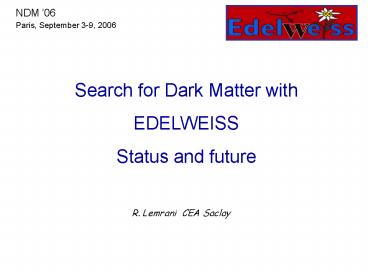R. Lemrani CEA Saclay - PowerPoint PPT Presentation
1 / 20
Title:
R. Lemrani CEA Saclay
Description:
Discrimination performance - g rejection 99.9% for Erecoil 15keV ... 50 cm PE and better coverage. veto (99% coverage) ... PE shielding. March 2005 ... – PowerPoint PPT presentation
Number of Views:52
Avg rating:3.0/5.0
Title: R. Lemrani CEA Saclay
1
NDM 06 Paris, September 3-9, 2006
Search for Dark Matter with EDELWEISS Status and
future
- R. Lemrani CEA Saclay
2
Modane Underground Laboratory
MAP
3
Ionization-heat cryogenic detectors
Thermometer
Edelweiss Ge bolometer
- Different charge/heat ratio for nuclear recoils
and electronic recoils - -gt event by event discrimination
4
Discrimination performance
252Cf calibration Neutrons in nuclear recoil band
60Co calibration no g below Q0.7
60Co
252Cf
-gt g rejection gt 99.9 for Erecoil gt 15keV
5
Lessons from EDELWEISS I 3x320 grams bolometers
Fall 2000 5 kg.d Spring 2002 8.6 kg.d -gt
astro-ph/0206271 Phys. Lett. B 545 (2002)
43 Oct.-Mar 2003 25.7 kg.d April-Nov 2003 22.7
kg.d Total 62 kg.d -gt astro-ph/0503265
V.Sanglard et al., PRD 71,122002 (2005)
6
g-ray background in EDELWEISS-I
- At low energy 1.5 event/kg/day/keV
- At high energy, data consistent with simulations
of the measured U/Th contamination in the Cu
shielding
7
Neutron background in EDELWEISS-I
Neutron calibration run 252Cf
Neutrons in Low background runs
Simulation with neutrons from U/Th in rock, U
in Lead and Copper shielding
- Simulation 2 nuclear recoil in 62 kg.d
- Data 1 n-n coincidence (double/single 1/10)
- -gt Not a strong constraint on singles
- (Indistinguishable from the miscollected events)
- 1 n-n ? 1 40 singles with ERgt15 keV _at_ 90 C.L.
- -gt agreement between
- data and MCNPX simulation
8
Surface backgrounds in EDELWEISS-I
- Peak at E5.3 MeV and Q0.3 (400 /m2/d)
- -gt surface as from 210Po?
- No 206Pb recoil peak at 100 keV
- (observed as heat-only events)
- -gt 210Pb implanted in Cu, not Ge.
- Rate of surface bs consistent
- with 210Pb hypothesis
- but does not exclude possible
- contribution from 14C
- -gt Remove Cu covers between detectors Should
remove background and allow identification by
coincidences
E 5.3 MeV, Q 0.3
1
9
Exclusion limit Spin Independent
- Best sensitivity 1.5x10-6 pb _at_ 80 GeV/c²
- EDELWEISS started to explore some optimistic SUSY
models
EDELWEISS-II
EURECA
- Need a gain in sensitivity of a factor 100
10000 (EDW-II, EURECA) to explore more
interesting SUSY models
10
EDELWEISS-II
- Installation in the LSM started January 2005
- 1rst funded stage 28 detectors
- 21320g optimized Ge/NTD detectors
- and holders
- 7400g Ge/NbSi detectors with active
- surface events rejections
- First cryogenic test with bolometers in january
2006 - Commissioning run with 9 bolometers on-going
- Goal factor 100 increase in sensitivity
- with up to 120 detectors in cryostat
- -gt ?w-n ? 10-8 pb
- -gt 0.002 evt/kg/day (ERgt10keV)
11
EDELWEISS-II Cryostat
computer control
- Nitrogen free 3 Pulse tubes (50K and 80K
screens) - and 1 He cold vapor reliquefier (consumption
? 0) - Large volume 50l ? Self shielding
- Up to ? 120 detectors ? More statistics
- Compact and hexagonal arrangement ? More
coincidence (n bkg)
12
EDELWEISS-II Backgrounds improvements
- -gt Better material selection
- (dedicated HPGe detectors)
- -gt Clean Room
- (class 100 around the cryostat,
- class 10000 for the full shielding)
- -gt Deradonised air factory
- 100 m3/h - 0.1 Bq/m3
- (instead of 5 Bq/m3)
- -gt Better shielding
- 20 cm Pb shielding
- Neutron Shielding
- 50 cm PE and better coverage
- µ veto (99 coverage)
13
Identification of surface events with Ge/NbSi
sensors
Athermal phonon measurement with NbSi thin film
thermometers
- Heat and ionization Ge detectors
- For surface events, athermal signal higher on one
face - Thermal signals proportional to the deposited
energy
g-ray 57Co calibration
- Improvement by a factor 20 of the rejection
- Fiducial volume reduction of 10
- Similar results on low-background runs in LSM
Before rejection
After rejection (1mm cut)
14
EDELWEISS-II Ge/NTD detectors
- Amorphous Ge and Si sublayer (better charge
collection for surface events) - Optimized NTD size and homogeneous working T
(16-18 mK) sub keV resolution - Low radioactivity new holders and connectors
(Teflon and copper only)
15
EDELWEISS-II present status
- Commissioning run with 9 bolometers
- 2320g Ge/NTD with EDW-I holder
- 2320g Ge/NTD with EDW-II holder and teflon clamp
- 2320g Ge/NTD with EDW-II holder and Cu springs
- 1IAS 50g heat and light detector (Al2O3)
- 1200g 1400g Ge/NbSi
- Goals Validation of the microphonics (pulse
tube decoupling system), new holders and new comb
connectors for Ge/ntd, new electronics scheme,
new acquisition system - Cold and running
- 28 detectors October 2006 (produced and tested)
First events
16
PE shielding March 2005
Vetos June 2005
17
Cryostat, copper screens and shielding waiting in
boxes in the clean room. Oct 2005
18
- Cabling Dec 2005
- for 60 bolometers in first stage
- ?1200 coaxes _at_ 300K !
- ? 500 coaxes _at_ 1 K, 100mK 10 mK
- ? 300 FET and 600 R or C at low T
19
Installation of the first detectors January 2006
20
Conclusions
The validation stage of EDELWEISS-II with 9
detectors is in progress Installation of 28
detectors (21 NTD-based Ge, 7 NbSi Ge) is
expected in October Several new techniques
implemented in EDELWEISS-II - new digital
electronics - new reversed dilution cryostat -
much larger experimental volume ( 50 liter
useful volume) - pulsetubes and helium
reliquifier - active muon veto When 28
detector-phase validated, request for funding of
100-detector stage Aim 2 x 10-8 picobarn
sensitivity Validation of the strategy towards
the EURECA ton-scale experiment































